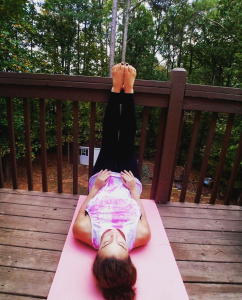Raise your hand if you rolled your eyes after seeing the title to this column. It’s OK, because usually I roll my eyes whenever I see endometriosis and yoga in the same sentence, too. After my endometriosis diagnosis, I felt like a hostage to my own body. I felt weak, betrayed, and powerless. I did not believe anything would help me find comfort or relief. The everyday pain felt as though it was beyond repair.
If I had to guess, many of you reading this have felt that way, too. These are typical feelings you will experience as a response to having a chronic illness. And it is not wrong to feel like this. However, it is vital that we do not let ourselves become stuck in a rut. Whenever I saw posts about yoga, I would laugh and think how that would never help me. Pain and fatigue would set in and yoga would always be the last thing on my mind. But the more I brushed things off, the more of a rut I fell into.
Yoga
I started to become more open to trying natural remedies to help me feel better. Sure enough, yoga ended up being No. 1 on my list. I learned quickly that yoga did not just involve being flexible and practicing difficult moves for hours on end. In fact, yoga offers many poses, stretches, and variations. Yoga has helped me feel alive again. I am certainly not cured and will always have to deal with a bad day, but yoga has taught me to love myself, how to breathe, take a step back, and just take it one day at a time.
3 of my favorite poses for a chronic illness day

1. Malasana-garland pose
This pose is great when I am experiencing pelvic pain and feeling dizzy. Garland pose opens up the pelvic area and helps ease pain and increase circulation. To practice this pose, stand at the top of your mat with your arms at your side. Move your feet so they are about as wide as your mat. Bend your knees slowly and come into a squat. Keep your thighs separated and a little wider than your torso. Lean forward slightly, with your heels still touching the ground. Bring your elbows along the inside of your knees and palms in prayer position. Shift your weight onto your heels, and keep your spine straight and shoulders relaxed. Breathe and hold for five minutes.
Modify: If you are having trouble balancing or feel pain in the knees, put a soft yoga block beneath you to rest your bottom on.

2. Balasana-child’s pose
This pose opens my back and hips and even helps with my migraines. This pose is known to help relieve cramping, soothe anxiety, and release tension. It also helps when I am feeling fatigued or dizzy.
To practice this pose, start on your hands and knees. Spread your knees apart while keeping your big toes touching one another. Sit up straight and begin to slowly bow forward. Your chest will rest on your thighs and your forehead will touch the floor. You can keep your arms extended in front of you or you can put them alongside your body. Breathe and hold for five minutes.
Modify: If you cannot get your head all the way to the floor, put a soft yoga block in front of you. You can rest your forehead on the block. Resting your forehead on the block also helps with migraines.

3. Viparita Karani-legs up the wall pose
This pose helps when I have pain in my legs or period cramps. It is known to improve the flow of blood to the pelvic region, refresh tired legs, and calm you. To practice this pose, lay on your back facing a wall. Gently walk your feet up the wall until your legs are resting on the wall. Be sure your bottom is as close to the wall as you can get it. Rest your hands on your stomach or out to your sides. Close your eyes, breathe, and hold for five minutes.
Modify: Place a pillow or towel under your lower back to relieve additional strain. You can also place a pillow or mat for support under your head. Use a strap around your thighs and knees to help hold legs in place. This helps take pressure off the lower back and pelvis.
You can follow more of my journey at: http://www.myendojourney.org
***
Note: Endometriosis News is strictly a news and information website about the disease. It does not provide medical advice, diagnosis, or treatment. This content is not intended to be a substitute for professional medical advice, diagnosis, or treatment. Always seek the advice of your physician or other qualified health provider with any questions you may have regarding a medical condition. Never disregard professional medical advice or delay in seeking it because of something you have read on this website. The opinions expressed in this column are not those of Endometriosis News or its parent company, BioNews Services, and are intended to spark discussion about issues pertaining to endometriosis.

